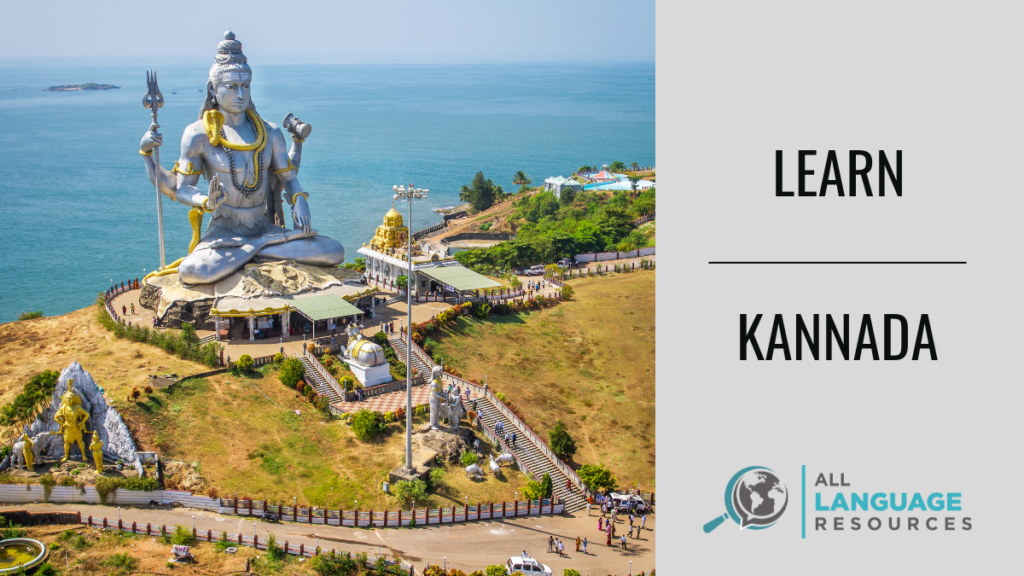Learning Kannada is a rewarding, fascinating, and occasionally frustrating experience. Yet sometimes the most challenging thing can be finding good learning resources and – especially if you’re not in Karnataka – practice opportunities.
Learn Kannada on your own efficiently with this ultimate guide. Learn how to get started, explore grammar, resources, tips, and answers to FAQs. Dive in.
- A Quick Introduction to the Kannada Language
- How Difficult Is Kannada?
- How to Learn Kannada: Some Quick Tips
- How Can I Teach Myself Kannada?
- What’s the Best Way to Learn Kannada?
- What’s the Easiest Way to Learn Kannada?
- How Long Does it Take to Learn Kannada?
- How to Learn Kannada Fast
- Additional Resources for Learning Kannada

Never fear: we’re here to give you recommendations on the best courses, apps, classes, textbooks, and more for learning this poetic language, as well as several study tips. We’ll also explore how difficult Kannada is and the best way to learn the Kannada script.
A Quick Introduction to the Kannada Language
Kannada is the language of Sandalwood cinema, some of India’s oldest literature, and roughly 50 million people across the globe.
The earliest existing example of written Kannada, the Halmidi Inscription, dates back around 2,500 years. (Living in or visiting Karnataka? You can see it for yourself in the striking Government Museum in Bengaluru.)
The prolific quantity of Old Kannada literature has led to Kannada being officially labeled a Classical language of India. And as a Dravidian language, it has a lot in common with other major literary languages such as Tamil, Telugu, and Malayalam (but a bit less in common with Hindi and Urdu).
Today, it’s spoken mainly in the South Indian state of Karnataka, home to major cities such as Bengaluru and Mysuru (previously known as Bangalore and Mysore); heritage sites such as Hampi and Pattadakal; and incredible natural sights such as Agumbe and the Kudremukh mountain range. You will also hear it spoken in neighboring states, however, and among diaspora communities.

Depending on where exactly you are in Karnataka, you might overhear a different variant of this language. There are significant southern, northern, and coastal differences, not to mention social and class-based ones.
Kannada also has something called diglossia: a feature in which there are multiple variants of a language in the same community. This means that formal, written Kannada is different from spoken Kannada – although, depending on who you ask, this difference can either be “not strongly marked” or “considerable.” Realistically speaking, how big the difference seems will depend on the dialect you’ve learned.
And like many Indian languages, Kannada has its own – beautiful, flowing – script and several loan words from Sanskrit, Arabic, Persian, and English.

How Difficult Is Kannada?
The US Foreign Services Institute (FSI) is many people’s port of call when deciding how difficult a language really is for English speakers. While the FSI’s website doesn’t explicitly mention Kannada, many people consider it to be in line with their Category III languages, meaning it would sit alongside Tamil, Telugu, Urdu, and Hindi.
So, what does that mean for you? Well, the FSI reckon that if you were to intensively study a Category III language for 25 hours a week, you’d reach professional working proficiency after 44 weeks, or roughly 10 months.
Of course, “professional working proficiency” is a pretty vague description. It’s been compared to both the B2 and C1 CEFR levels, so if you’re considering an intensive course, take a look at the description of the levels.
Now, ten months to get to B2/C1 really isn’t bad, but most of us won’t be able to study for 25 hours a week (plus homework!). So, realistically speaking, how difficult is Kannada and how long will it take you to learn it?
The (frustrating) answer is: it depends.
Let’s say you already speak a similar language – perhaps Malayalam, Telugu, or Tamil – and get to use Kannada every day. You’ll find yourself picking it up a bit quicker.
On the other hand, let’s say that you only speak English and rarely get to speak Kannada outside of your classroom or dedicated studies. You’ll find yourself forced to be more of a tortoise than a hare. You’ll likely need to review your notes more frequently, do extra exercises and drills, and actively seek practice opportunities.
Still, if you’re considering Kannada, don’t get discouraged by the idea that it might be difficult. Learning a language is fascinating, fun, and incredibly rewarding. While it’s a cliché, treat it as a marathon rather than a sprint, and focus on what you can do rather than what you can’t.
Instead of obsessing over fluency, give yourself smaller goals: aim to have a 5-, 20-, or 45-minute conversation; read a short story, newspaper article, or a book; keep a diary; listen to a podcast; or sing along to a song.
When you break it down into achievable goals, learning Kannada doesn’t seem quite so challenging.

How to Learn Kannada: Some Quick Tips
There’s no foolproof way to learn a language, but we can offer you some tips:
Identify your goals
What do you actually want to do with the Kannada language? If your aim is to speak with the Kannadiga side of your family, then you’ll need to hone in on your speaking and listening skills. It will also make sense to learn some of the vocabulary specific to the topics your family likes to talk about.
So, if discussions over politics typically break out, start reviewing phrases for talking about politicians and taxes. Or if your family likes to talk about the movies instead, drill up on genre-specific vocabulary.
Perhaps you’d actually like to use Kannada for work emails. Practice your reading and writing, and make a list of the business-specific phrases you’ll need to know.
Or maybe you’re planning to go on vacation in Karnataka. (Count us jealous: Hampi is awe-inspiring and the food is mouthwateringly good.) You probably won’t need as great a mastery of political or business phrases, but you’ll want to learn a lot of basic travel, hotel, and directions-based vocabulary.
Create a study plan
Now you know what you want to study, decide how and when you’re going to do it. But be realistic! If you’re a busy person, you’re unlikely to have two hours a day, seven days a week to study.
Go at a manageable rhythm. You don’t want to dread your study sessions. And if you’re struggling to fit them in, try to study for less time but more frequently. It will be more effective than a long, intense session of cramming once a week.
If you get busy, re-evaluate your schedule. And if you fall off the wagon and skip a week? Relax, it happens. Just start again. Perhaps try doing a quick refresher of the most recent material to ease your way back into it.

Decide how you’re going to study
We’re going to explore a huge number of courses, textbooks, apps, podcasts, YouTube channels, online classes, and more in this article. We’ll tell you our honest opinion of them, and for many of them, you can click through and read a more detailed review along with a rating.
But not every resource is well suited to every learner. You might prefer visually attractive worksheets and grammar-based explanations. Or you find you learn best by speaking and or listening. So, take this into account when choosing between resources, and don’t be afraid to try a few out to see what works best.
As well as the resources we’re about to cover, you can also:
- Journal
- Follow Kannada-language vloggers, influencers, and hashtags
- Find Kannada-language Facebook groups or forums related to your hobbies
- Write book/movie reviews, a blog, or short stories in Kannada
- Attend comedy shows or poetry readings (you’ll find virtual ones online)
- Write a letter to the editor of a Kannada-language newspaper or site
- Change the settings on your search engine so that it shows you Kannada-language results first
- Create flashcards
- Label things around the house in Kannada
No matter what methods you choose, try to do a bit of speaking, listening, reading, and writing. And look for a certain degree of balance between grammar, vocabulary, and culture.
Track your progress
It can be hard to see your progress on a day-to-day basis, and this can make learning a language demotivating. Some days, you’ll feel like your listening ability has deteriorated. Other days, you’ll struggle to remember “basic” vocabulary that you learned and drilled five months ago, only to never use it again. (After all, how often do you say the words “mouse,” “accountant,” and “ice” in everyday life?)
First, don’t feel bad about this: it is a normal part of learning a language and doesn’t actually mean your Kannada knowledge has decreased. In fact, if you track your progress, you will still see an overall improvement.
So, instead of beating yourself up because you didn’t understand someone, reread something you read or wrote a few months ago, rewatch a TV show, or relisten to a podcast. You’ll be pleasantly surprised by just how far you’ve come.
Reward yourself by doing fun things in Kannada
We’re not talking about reading a level-appropriate book to practice your reading. Sure, it’s a great way to study – but we want you to actually reward yourself, not just add to your homework list.
Try watching a movie because the trailer looks amazing. Don’t worry about whether you have subtitles on, pause to look up what a word means, or do any “good” language-learning tricks: this is fun, not studying.
Read a comic even though nearly all the communication is visual, not verbal. Trawl through forums dedicated to your hobbies. Add terrible puns to your shopping list because they’ll make your housemates giggle. Bake a delicious dessert, not to challenge your cooking vocabulary but because you really want to eat bread halwa.
Remember, you learn a language so you can enjoy using it. Why not start right now, rather than putting it off?

How Can I Teach Myself Kannada?
You can teach yourself Kannada by piecing together your own curriculum from the wealth of resources recommended in this article. It is a good idea to provide structure to your learning by starting with an online course, app, or tutor.
This helps ensure that you cover all the key aspects of the language and don’t skip something important, like how to pronounce spoken words or an important grammar concept. Then add on as many auxiliary activities as you can fit into your designated study time!
What’s the Best Way to Learn Kannada?
The best way to learn Kannada for you depends on why you want to learn. If you really want everyday conversational skills, you may want to look into a tutor or seek out an in-person class at a local temple. If you want to study literature or classic text in written Kannada, you may want a course of study that focuses heavily on grammar.
What’s the Easiest Way to Learn Kannada?
The easiest way to learn Kannada is to pick tools that fit your learning style. If you learn visually, an app or online course will probably work well for you. If you have an auditory learning style, YouTube videos, and online courses with lots of native speaker audio content will help you more.
It’s also worth considering what motivates you. If you love lots of mini rewards for completing learning goals, an app like Ling might help you more than a less gamified model or a textbook.
How Long Does it Take to Learn Kannada?
For most English speakers, learning Kannada to a level of basic proficiency will require about 900 hours of dedicated study or class time. This breaks down to about two and a half years if you can study for just one hour a day.
Of course, if you plan to live in Karnataka during your study time period, you may learn much more quickly!
How to Learn Kannada Fast
The best way to learn Kannada fast is to put yourself in situations where you need to speak in Kannada and cannot rely on English. If you can travel, go for it! If not, sign up for one of the free conversation exchange options mentioned in this article.
The great thing about online conversation groups is that you will have a safe, supportive audience for your first attempts at speaking Kannada in real life, but you will still feel the pressure to practice.
Additional Resources for Learning Kannada
In addition to Kannada learning apps and courses, having several supplementary resources when learning the language is a smart choice. Textbooks or other forms of media that appeal to your interests could make learning Kannada much more enjoyable.
Kannada Textbooks
Using a textbook can add structure to your studies, especially if you haven’t signed up for a course or classes. Bear in mind that while textbooks can give you a good foundation in grammar and vocabulary, you might need to look elsewhere to practice listening. Plus, your spoken Kannada will definitely benefit from a language exchange.
Conversational Kannada: A Micro-Wave Approach grew out of the author’s experience of training volunteers in the American Peace Corps. It’s praised as one of the best resources available, especially for beginners, although some students find the structure frustrating.
Learn Kannada in 30 Days through English by Ranga Rao is a hit-or-miss book. Generally, learners love the content but find the print slightly too small, especially when it’s explaining the script.
Whatever you do, don’t confuse Ranga Rao’s book with Learn Kannada in 30 Days Through English by Krishna Gopal Vikal. Its frequent errors and tiny print leave most learners frustrated.
If you’re just hoping to get by in Kannada, you might like Non Kannadiga To Naanu Kannadiga (assuming you can get your hands on a copy). It focuses on spoken Kannada, doesn’t use the Kannada script, and keeps grammar explanations to a bare minimum.

Kannada Fiction Books and Poetry
As a Classical Language of India, Kannada has a rich literary history that stretches from the ninth-century Kavirajamarga through to the modern day. But while there are numerous classic poems that are worth reading, you’ll probably find it easiest to begin with something more modern.
Beginner and lower-intermediate Kannada learners might prefer to read children’s short stories. Tulika Books also sells books for beginner readers.
Ready for something designed for adults? Masti Venkatesha Iyengar was a prolific short story writer and often referred to as “Kannada’s Treasure.” Alternatively, try K.P. Poornachandra Tejaswi, an award-winning poet, short story, and non-fiction writer.
If you can find Mohanaswamy by Vasudhendra in Kannada (or even in English, Tamil, or Marathi), it’s worth the read. This poignant short story collection centers on the experiences of Mohanaswamy, a gay man who is blackmailed, struggles with online dating, and has to accept that his lover has decided to marry a woman.
Grubahbahnga by S.L. Bhyrappa explores witchcraft, religion, and local superstitions in Karnataka. If you like it, read Vamshavruksha and Parva next.

Sandalwood Cinema: TV and Movies in Kannada
Turn your downtime into study time by watching Kannada-language TV shows and movies. Not only is it fun but you’ll find yourself picking up more colloquial phrases and getting used to a wider variety of accents. Plus, you’ll always have a good topic of conversation to fall back on.
Even if quiz shows aren’t your thing, it’s worth searching for episodes of Thatt Antha Heli on YouTube. This series tests participants on idioms, proverbs, riddles, synonyms, and more, making it ideal for language learners.
Ready to get lost in a movie? You’ve got plenty to choose from. Sandalwood, aka Kannada’s cinema industry, is thriving.
The dramatic comedy Thithi looks at how three generations of men respond to the death of the 101-year-old man who was their father, grandfather, or great-grandfather. It won awards and has been praised for its touching humanity as well as its satire.
Romantic comedy Kirik Party tells the story of a group of engineering students. Be warned: it was hit or miss with viewers.
Crime drama Ulidavaru Kandanthe weaves together the stories of five different characters. While it had a lukewarm reception with critics, it was a box-office hit and viewers had high praise for it.
In Chowka, five prisoners are jailed for crimes they didn’t commit. Viewers found it gripping, despite the three-hour running time.
When a middle-aged man with Alzheimer’s goes missing in Godhi Banna Sadharana Mykattu, his son sets out to find him. Add murder, land scams, and crooked cops to the mix, and this touching movie veers toward the dramatic.
The award-winning Dweepa explores the issue of forced displacement and why we remain attached to places and people. While one of the older movies on this list, it still feels relevant today.
For something a little more surreal, try Lucia, a crowdfunded movie that has been compared to Inception. It’s drawn glowing reviews from critics, but don’t feel bad if you struggle to follow the plot – it’s quite complex.
Watching Sandalwood shows on Netflix? Try using the Language Learning With Netflix plugin, which we think can help you understand the subtitles and revise new vocabulary.

News, Music, and Other Resources for Learning Kannada
While listening to music isn’t exactly studying, it further immerses you in Kannada, introduces you to extra vocabulary, and gets you thinking more in the language (especially if you like to sing along).
Make sure you find the music you like, rather than just adding songs to your playlists because they’re in Kannada. Try listening to multi-genre playlists like Spotify’s official ones: Latest Kannada and Kannada Indie. Alternatively, use that search bar – there are dozens, if not hundreds, to choose from.
Before you go using the new phrases with your friends, make sure you’ve looked them up in the dictionary and understand the context of them. Just because something’s said in a rap song doesn’t always make it suitable for everyday use. You might like the open-source Kannada-to-English dictionary Alar. Or, try English–Kannada.com.
These dictionaries will also come in handy for reading the news – something that won’t just get you practicing your reading but will also keep you up to date on what’s happening in Karnataka and the world. (Plus, how else will you understand all those Kannada-language memes on social media?)
Since every news site has its own editorial slant, not to mention more or less complex language, try a few out to find one you get on with. Here are a few options:

Even though you won’t find Kannada courses on Rosetta Stone and it’s absent from Duolingo, there’s a surprisingly large number of ways to study this beautiful language.
So, try out a Kannada course, book classes with a teacher, and start reading the imaginative novels of some of Karnataka’s greatest authors. It won’t be long until you’re speaking Kannada with confidence.
Related Posts
If you found this article useful, you might also like:

